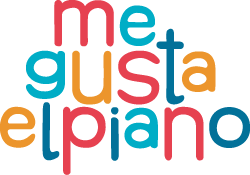Today is a very exciting day for me because a project comes to light in which I have been working with great enthusiasm for several months. It’s called Piano Notebook. In this post, I’ll briefly describe what this idea consists of and I’ll explain in more detail the first publication of the series.
Piano Notebook
Piano Notebook is a project created to provide various materials, resources, ideas and activities for piano teachers with elementary and intermediate level students.
Each publication will address a topic related to piano pedagogy. Depending on the topic of each notebook, different materials will be included, such as compositions, improvisations, arrangements, technical exercises, audios, card sheets, theory and rhythm.
It will all be sold in PDF format with a studio license, which will allow teachers who purchase it free and unlimited use with their own students.
Piano Notebook 1
The first Notebook uses pentascales (the first five notes of a major or minor scale.) Practicing pentascales creates the basis for solid technique and is an essential tool for developing musical comprehension.
This publication contains 24 eight measure pieces designed for practicing all major and minor pentascales. They are written in different meters and styles with the intention of covering as wide a variety of piano textures as possible. The simplicity of their compositional structure favors easily transposing each piece to any other key. It also allows students to change the mode, meter or rhythm.
Piano Notebook 1 contains:
- 24 pieces in all keys, each one eight measures long and in the five-finger position
- 24 audio files
- Printable card sheets of all keys, pentascales, key signatures and time signatures to use in different activities.
- A tracking chart for the 24 keys.
Ways to use Piano Notebook
The material contained in this publication can be used in very different ways depending on the student and the pedagogical goal. Here are some ideas:
•The simplest way is to play the pieces of the Notebook as they are written. This way students will be able to play pieces in all keys in addition to their repertoire pieces. The student practices sight-reading with the added benefit of being exposed to a large variety of keys, textures, rhythms and meters.
• The Miniatures can also be used as preparation or warm-up for the student’s repertoire pieces, selecting a Miniature written in the same key as the piece.
• Another way to use them is to practice each piece in as many different ways as possible. As you can imagine, this is my favorite approach because of the benefits it brings to students. The harmonic and compositional simplicity of the pieces allows great flexibility in creating variations such as:
· changing the key of the piece.
· changing the third note of the pentascale to modulate from major to minor and vice versa.
· changing the meter of the piece. For example, adapting a piece written in 4/4 to 3/4, or 6/8, or even 5/8.
· Changing the character, rhythm, articulation, dynamics or tempo of the piece.
· Finally, inventing a new piece using elements of the Miniature as a starting point.
Here is an example of Miniature 1 played in different ways:
Printable card sheets
Cards from the printable sheets in the second part of the notebook can also be used in several ways. Here are just a few examples of how to use them:
• match the key cards with the key signature cards or with the corresponding five notes.
• transpose to a random key from a selection of cards that you want to work on.
• guess by ear and select the card corresponding to the key/mode/tonality* or meter of the piece the teacher is playing.
• Play Memory (also known as Concentration, Match-Match or Pairs). To do this, pairs must be established by relating key signatures with key names or positions on the keyboard, or with the notes on the staff.
• Sort the cards according to the circle of fifths.
• Guess the card. Every player has to place a card without seeing it on their own forehead (keys, key signatures or meter).The aim of the game is to guess your own card with the clues of others (playing a piece in the same meter or key, for example.)
For those who are interested, this publication can be purchased on the blog’s store. You can also join the Facebook group Piano Notebook where I will share videos with various activities to use the different materials of the notebooks. Finally, if you have any questions about this or future materials you can contact me by email at info@megustaelpiano.com.




Good afternoon!
I am just checking in on the level of this resource.
Intermediate means conservatory levels 3-5?
I follow the Royal Conservatory of Music (Canada).
This material looks like it could fill in the gaps for my students — simple pieces, written in modern styles that are pedagogically sound. Looking for material levelled below their RCM level to enable them to develop depth in sightreading and artistry.
Hello Katrina, I think the pieces are perfect for those levels, better for level 3 and level 4. In this video you can listen to all the pieces in the book: https://youtu.be/80BPUWz1Jn8
Thank you for your message!